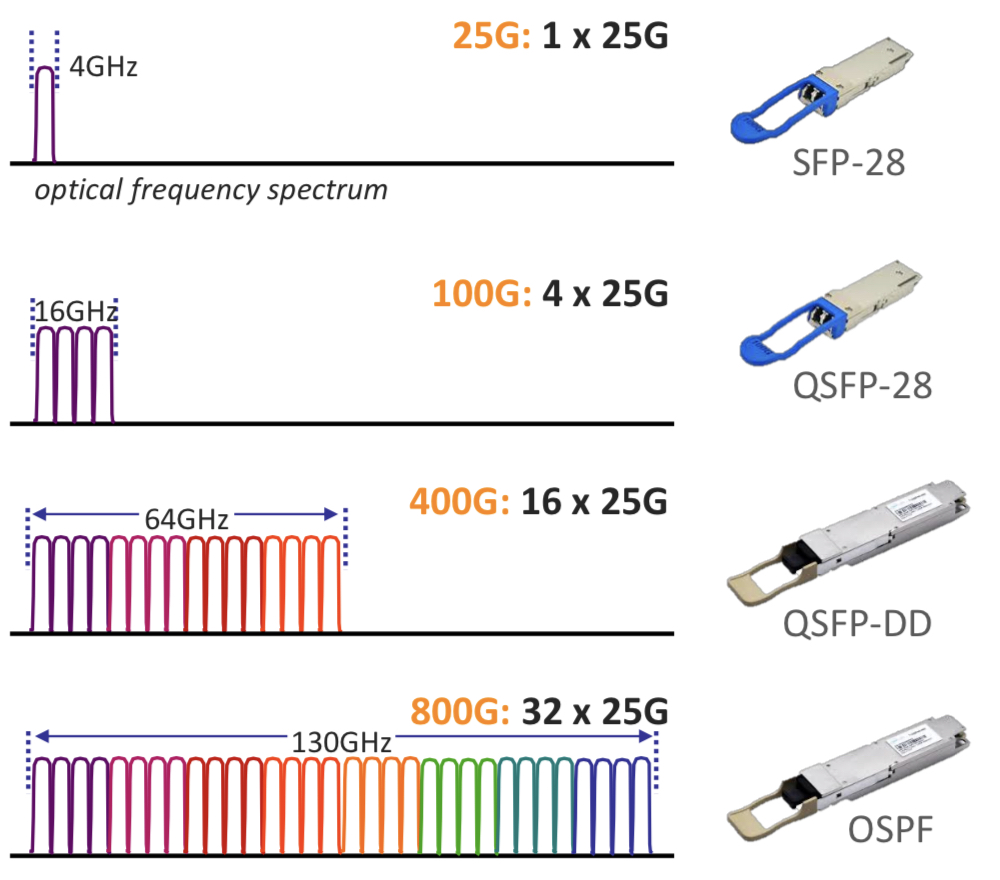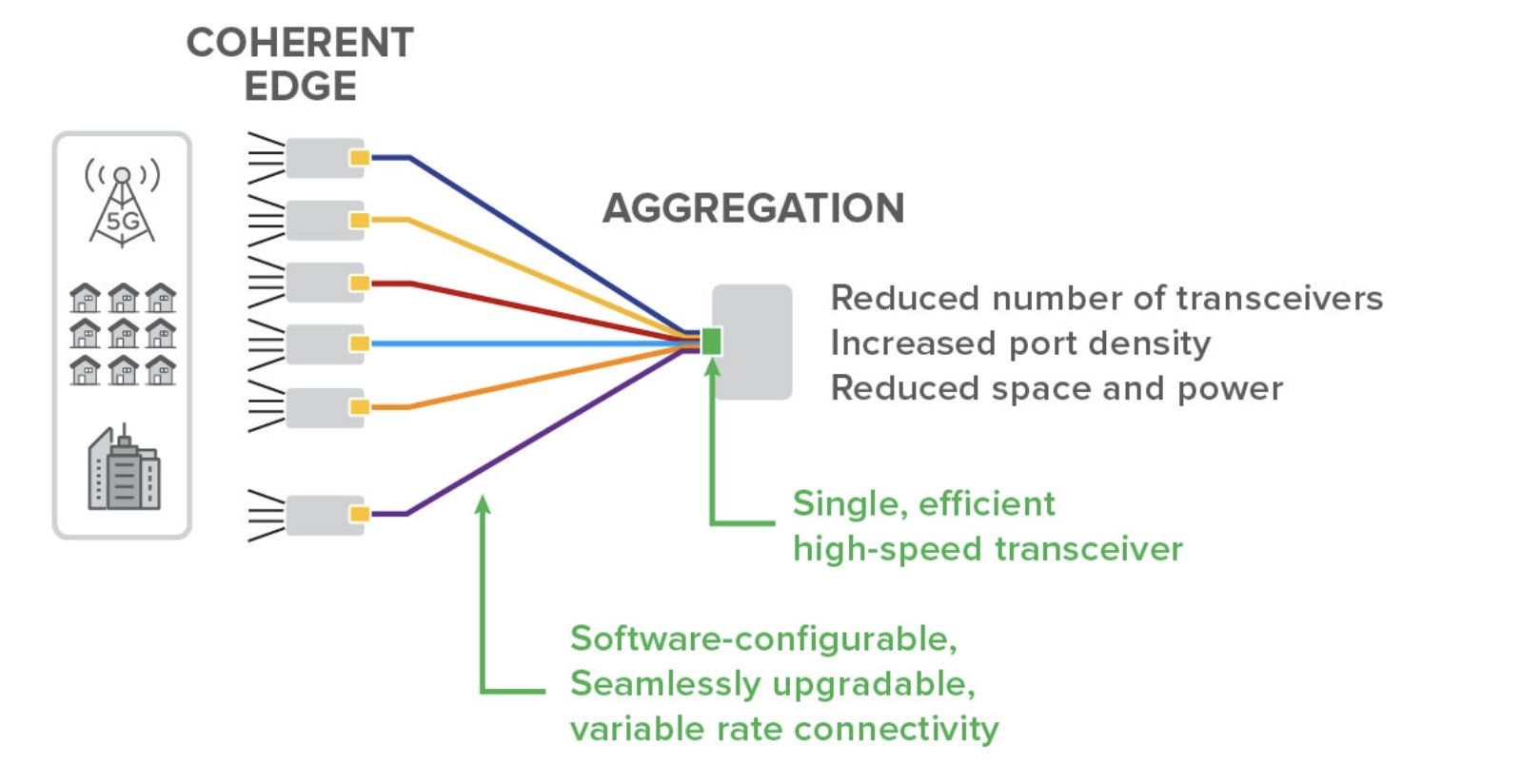Infinera rethinks aggregation with slices of light
 Friday, September 27, 2019 at 7:04AM
Friday, September 27, 2019 at 7:04AM An optical architecture for traffic aggregation that promises to deliver networking benefits and cost savings was unveiled by Infinera at this week’s ECOC show, held in Dublin.
Traffic aggregation is used widely in the network for applications such as fixed broadband, cellular networks, fibre-deep cable networks and business services.
 Dave Welch
Dave Welch
Infinera has developed a class of optics, dubbed XR optics, that fits into pluggable modules for traffic aggregation. And while the company is focussing on the network edge for applications such as 5G, the technology could also be used in the data centre.
Optics is inherently a point-to-point communications technology, says Infinera. Yet optics is applied to traffic aggregation, a point-to-multipoint architecture, and that results in inefficiencies.
“The breakthrough here is that, for the first time in optics’ history, we have been able to make optics work to match the needs of an aggregation network,” says Dave Welch, founder and chief innovation officer at Infinera.
XR Optics
Infinera came up with the 'XR’ label after borrowing from the naming scheme used for 400ZR, the 400-gigabit pluggable optics coherent standard.
“XR can do point-to-point like ZR optics,” says Welch. “But XR allows you to go beyond, to point-to-multipoint; ‘X’ being an ill-defined variable as to exactly how you want to set up your network."
XR optics uses coherent technology and Nyquist sub-carriers. Instead of using a laser to generate a single carrier, pulse-shaping is used at the transmitter to generate multiple carriers, referred to as Nyquist sub-carriers.
The sub-carriers convey the same information as a single carrier but by using several sub-carriers, a lower symbol rate can be used for each. The lower symbol rate improves the tolerance to non-linear effects in a fibre and enables the use of lower-speed electronics.
Infinera first detailed Nyquist sub-carriers as part of its advanced coherent toolkit, and implemented the technology with its Infinite Capacity Engine 4 (ICE4) used for optical transport.
The company is bringing to market its second-generation Nyquist sub-carrier design with its ICE6 technology that supports 800-gigabit wavelengths.
Now Infinera is proposing coherent sub-carriers for a new class of problem: traffic aggregation. But XR optics will need backing and be multi-sourced if it is to be adopted widely.
Network operators will also need to be convinced of the technology’s merits. Infinera claims XR optics will halve the pluggable modules needed for aggregation and remove the need for intermediate digital aggregation platforms, reducing networking costs by 70 percent.
Aggregation optics
XR optics will be required at both ends of a link. The modules will need to understand a protocol that tells them the nature of the sub-carriers to use: their baud rate (and resulting spectral width) and modulation scheme.
Infinera cites as the example a 4GHz-wide sub-carrier modulated using 16-ary quadrature amplitude modulation (16-QAM) that can transmit 25-gigabit of data.
A larger capacity XR coherent module will be used at the aggregation hub and will talk directly with XR modules at the network edge, “casting out” its sub-carriers to the various pluggable modules at the network edge.
For example, the module at the hub may be a 400-gigabit QSFP-DD supporting 16, 25-gigabit sub-carriers, or an 800-gigabit QSFP-DD or OSFP module delivering 32 sub-carriers. A mix of lower-speed XR modules will be used at the edge: 100-gigabit QSFP28 XR modules based on four sub-carriers and single sub-carrier 25-gigabit SFP28s.
 Source: Infinera
Source: Infinera
“As soon as you have defined that each one of these transceivers is some multiple of that 25-gigabit sub-carrier, they can all talk to each other,” says Welch.
The hub XR module and network-edge modules are linked using optical splitters such that all the sub-channels sent by the hub XR module are seen by each of the edge modules. The hub in effect broadcasts its sub-carriers to all the edge devices, says Welch.
A coding scheme is used such that each edge module's coherent receiver can pick off its assigned sub-channel(s). In turn, an edge module will send its data using the same frequencies on a separate fibre.
Basing the communications on multiples of sub-carriers means any XR module can talk to any other, irrespective of their overall speeds.
Sub-carriers can also be reassigned.
“In that fashion, today you are a 25-gigabit client module and tomorrow you are 100-gigabit,” says Welch. Reassigning edge-module capacities will not happen often but when undertaken, no truck roll will be needed.
System benefits
In a conventional aggregation network, the edge transceivers send traffic to an intermediate electrical aggregation switch. The switch’s line-side-facing transceivers then send on the aggregated traffic to the hub.
Using XR optics, the intermediate aggregation switch becomes redundant since the higher-capacity XR coherent module aggregates the traffic from the edge. Removing the switch and its one-to-one edge-facing transceivers account for the halving of the overall transceiver count and the overall 70 percent network cost saving (see diagram below).
 Source: Infinera
Source: Infinera
The disadvantage of getting rid of the intermediate aggregation switch is minor in comparison to the plusses, says Infinera.
“In a network where all the traffic is going left to right, there is always an economic gain,” says Welch. And while a layer-2 aggregation switch enables statistical multiplexing to be applied to the traffic, it is insignificant when compared to the cost-savings XR optics brings, he says.
Challenges
XR transceivers will need to support sub-carriers and coherent signal processing as well as the language that defines the sub-carriers and their assignment codes. Accordingly, module makers will need to make a new class of XR pluggable modules.
“We are working with others,” says Welch. “The object is to bring the technology and a broad-base supply chain to the market.” The fastest way to achieve this, says Welch, is through a series of multi-source agreements (MSAs). Arista Networks and Lumentum were both quoted as part of Infinera's XR Optics press release.
Another challenge is that a family of coherent digital signal processors (DSPs) will need to be designed that fit within the power constraints of the various slim client-side pluggable form factors.
Infinera stresses it is unveiling a technological development and not a product announcement. That will come later.
However, Welch says that XR optics will support a reach of hundreds of kilometres and even metro-regional distances of over 1,000km.
“We are comfortable we are working with partners to get this out,” says Welch. “We are comfortable we have some key technologies that will enhance these capabilities as well.”
Other applications
Infinera’s is focussing its XR optics on applications such as 5G. But it says the technology will benefit many network applications.
“If you look at the architecture in the data centre or look are core networks, they are all aggregation networks of one flavour or another,” says Welch. “Any type of power, cost, and operational savings of this magnitude should be evaluated across the board on all networks.”



Reader Comments